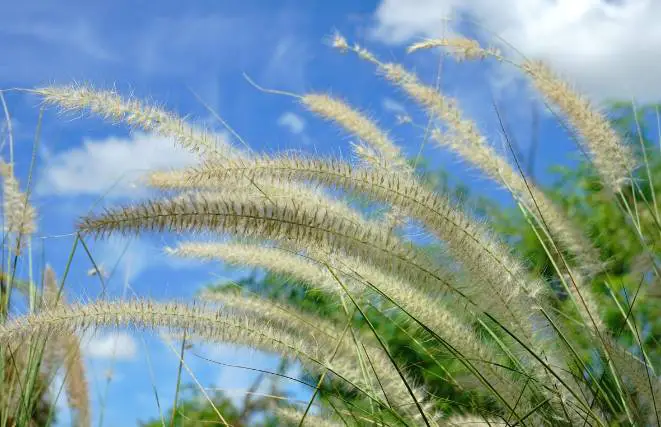Fountain grass, with its graceful plumes and swaying foliage, is a delightful addition to any garden. But to keep it looking its best, you need to know when and how to trim it. Don’t worry; it’s not as tricky as it might sound. In this guide, we’ll explore the when, why, and how of cutting back fountain grass, making it easy for gardeners of all levels to maintain this beautiful ornamental grass.
Understanding Fountain Grass
What’s So Special About Fountain Grass?
Fountain grass, scientifically known as Pennisetum, is loved for its soft, arching blades that resemble the cascading waters of a fountain, hence the name. There are different types, but the most popular is the Purple Fountain Grass (Pennisetum setaceum), known for its striking burgundy plumes.
Growth Habits
Fountain grasses are generally low-maintenance and easy-going. They grow in clumps, and their plumes sway gracefully in the breeze, creating a mesmerizing effect. However, like all plants, they benefit from some pruning to stay healthy and looking their best.
The Best Time to Cut Back Fountain Grass
Timing is Key
Knowing when to cut back your fountain grass is crucial. Timing it right ensures that your grass remains vibrant without causing undue stress. So, when is the best time?
Late Winter to Early Spring
The optimal time to trim your fountain grass is in late winter to early spring, just before new growth begins. Why? Here are some good reasons:
- Dormant Period: During this time, the grass is mostly dormant. This means it’s not actively growing, making it less stressful to prune.
- New Growth: Trimming before new growth starts allows the plant to put its energy into fresh, healthy shoots.
- Aesthetic Appeal: Pruning in late winter tidies up the garden for spring, creating a clean slate for the new season.
Signs that It’s Time to Prune
Listen to Your Grass
Your fountain grass will give you some clear signals when it’s time for a haircut. Look for these signs:
- Browning or Fading Foliage: If you notice the blades turning brown or losing their vibrant color, it’s a sign that they are aging and could benefit from a trim.
- Drooping Plumes: As the plumes age, they may start to droop and lose their fluffy appearance.
- Overcrowding: If your fountain grass is getting too dense, with blades growing too close together, it’s a sign that some thinning is in order.

Tools and Preparation
Gather Your Gardening Gear
Before you start pruning, make sure you have the right tools on hand:
- Pruning Shears or Hedge Clippers: These are perfect for trimming grasses.
- Gloves: Protect your hands from sharp blades and grass allergens.
- Eye Protection: Wear goggles or safety glasses to shield your eyes from flying debris.
Prep Your Work Area
- Clear Debris: Remove any fallen leaves or debris from around the grass to make your work easier.
- Secure the Area: If you’re using power tools, ensure the area is clear of obstacles and that there are no pets or kids around.
Step-by-Step Pruning Guide
Let’s Get to Pruning
Now that you’re prepared, it’s time to start pruning your fountain grass. The steps are straightforward:
- Cut Back the Grass: Using your pruning shears or clippers, trim the grass back to a height of about 2-4 inches from the ground. You can go a bit shorter if your grass is particularly large or overgrown.
- Collect the Clippings: As you trim, gather the clippings in a tarp or bin for easy cleanup.
- Dispose of the Clippings: Fountain grass clippings can be quite sharp, so it’s best to dispose of them in yard waste bags rather than composting them.
- Clean Your Tools: After you’ve finished, clean and oil your pruning shears or clippers to keep them in good working condition.
Pruning Variations for Different Climates
Adapting to Your Zone
The timing for pruning fountain grass can vary slightly depending on your climate zone:
- Warmer Zones (7-10): In warmer climates, you can often prune in late winter or very early spring.
- Cooler Zones (4-6): For cooler climates, it’s best to wait until early spring when the worst of the winter cold has passed.
Adjusting your pruning schedule to your specific climate conditions can help your fountain grass thrive.
Benefits of Proper Pruning
Why Bother Pruning?
Pruning your fountain grass might seem like extra work, but it comes with several benefits:
- Promotes Healthy Growth: Trimming encourages new growth, leading to a healthier, lusher plant.
- Enhances Appearance: Pruned grass looks neater and more vibrant, improving the overall look of your garden.
- Prevents Overcrowding: Regular pruning prevents overcrowding, allowing each blade to receive adequate sunlight and air circulation.
Common Mistakes to Avoid
Don’t Make These Pruning Blunders
To ensure your fountain grass thrives after pruning, steer clear of these common mistakes:
- Pruning Too Early: Don’t prune too early in winter when the grass is still actively growing.
- Cutting Too Short: While you can trim quite low, avoid cutting into the crown of the plant.
- Ignoring Safety Gear: Protect yourself with gloves and eye protection to avoid injury.
- Composting Clippings: The sharp clippings can harm your compost pile; it’s better to dispose of them separately.
Aftercare and Maintenance
Nurturing Your Pruned Grass
After pruning, your fountain grass will appreciate a little extra care:
- Fertilize: In early spring, apply a balanced, slow-release fertilizer to nourish the plant.
- Water: Give your grass a good drink after pruning to help it recover.
- Mulch: Apply a layer of mulch to help retain moisture and regulate soil temperature.
READ: Is Purple Fountain Grass a Perennial or Annual
When to cut back fountain grass in california
In California, where the climate varies from region to region, the best time to cut back fountain grass (Pennisetum) can depend on your specific location and local climate conditions. However, as a general guideline, you can consider the following:
- Coastal Areas: In coastal areas of California with mild winters, it’s often best to cut back fountain grass in late winter or early spring, around February or March. This timing allows the grass to benefit from some protection against potential frost while promoting new growth for the upcoming growing season.
- Inland and Desert Areas: Inland and desert regions of California may experience colder winter temperatures. In these areas, you can delay the cutback until late winter or very early spring, around March. This gives the grass some protection from winter chill while allowing you to remove any dead growth before the new growth begins.
Remember that fountain grass is quite adaptable and can tolerate a range of conditions. The timing of the cutback can vary based on local microclimates and specific weather patterns, so it’s a good idea to observe the local conditions and the grass itself. The goal is to prune it before new growth starts but after the risk of severe frost has passed.
FAQ
To winter over fountain grass (Pennisetum), start by trimming and pruning it in late winter or early spring to remove dead growth. Apply a layer of mulch around the base, but avoid covering the grass itself. In regions with harsh winters, consider using burlap or breathable fabric for additional protection. Reduce watering during the winter months, allowing the soil to slightly dry between waterings. Inspect the grass for pests and diseases, and address any issues promptly. In the spring, remove winter protection and gradually resume watering to encourage new growth and ensure the grass thrives in the upcoming season.
In Florida, the timing for cutting back fountain grass (Pennisetum) varies depending on your specific location within the state. In southern and coastal regions with milder winters, it’s typically done in late winter or early spring, around February or March. In central and northern Florida, where occasional freezes are possible, it’s advisable to wait until late winter or very early spring, around March. These timings strike a balance between protecting the grass from potential frost and preparing it for new growth in the upcoming season. However, local microclimates and weather patterns can influence the exact timing, so observation of the grass and local conditions is key.
Conclusion
The ideal time to cut back fountain grass depends on your location and local climate. In regions with mild winters, like Southern and Coastal Florida, late winter to early spring, typically February or March, is suitable. This timing offers some protection against late frosts while encouraging new growth. In areas with occasional freezes, such as Central and Northern Florida, it’s advisable to wait until late winter or early spring, around March, to prune the grass.
By timing it right, using the correct tools, and following the proper steps, you can keep your fountain grass looking its best. So, when late winter or early spring rolls around, grab your pruning shears and give your fountain grass a trim. Your garden will thank you with lush, vibrant growth and a stunning display of swaying plumes. Happy gardening!









